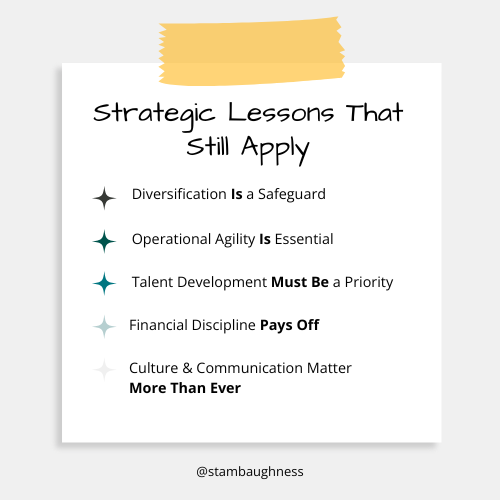Resilience by Design: How AEC Leaders Can Shape an Uncertain Future

The last economic recession, often called the Great Recession, started 17 years ago and was a seismic event for the architecture, engineering, and construction (AEC) industry. While we don’t expect the current uncertainty to cause as much disruption, the risk to the industry is real because many of the current AEC firm leaders were in the very beginning of their careers at that time. However, there are many of us who lived through that period and learned some tough lessons about firm survival. Many of those lessons are not only applicable today but also provide excellent business advice for creating a resilient firm in any economic situation.
A Harsh Reality Check
Much like today, the downturn of 2008-10 exposed critical vulnerabilities in AEC firms that had been masked during years of steady growth. Those that relied heavily on one sector found themselves overexposed. With fewer projects to pursue, competition intensified. Fee compression became the norm as firms vied for a shrinking pool of work. Profit margins thinned. Hiring froze. Internships disappeared. Many young professionals left the field altogether, resulting in what some now call a “missing middle” of mid-career talent.
Firms that survived did so by pivoting—quickly. Many shifted focus to public infrastructure projects, leveraging funding from the 2009 American Recovery and Reinvestment Act. Civil engineering firms with ties to transportation and utilities generally weathered the storm better. Others diversified their services, entering new markets such as education, healthcare, or energy efficiency. The crisis accelerated technology adoption, with Building Information Modeling (BIM) and other digital collaboration tools becoming more widespread, allowing teams to do more with fewer people and tighter timelines.
While the recovery was slow, it was also a time to reflect and learn. The 2008 downturn forced leaders to reevaluate their business fundamentals: cash flow, operational efficiency, and client diversity. It also reinforced a core truth: resilience isn’t built in times of comfort. It’s shaped by how firms respond to uncertainty, adapt their models, and lead through change.
Echoes of 2008 in Today’s Uncertainty
Fast forward to the present, and the AEC industry once again faces an uncertain horizon. We want to emphasize again that we are not in the midst of a financial crisis of the same magnitude as 2008; today’s environment carries its own form of complexity: economic volatility, high interest rates, inflation, labor shortages, supply chain disruptions, and mounting pressure from global challenges.
AEC firm leaders are navigating:
- Rising construction costs that delay or downsize capital projects.
- Talent retention issues in an increasingly competitive labor market and demographic shifts.
- Uncertain public sector funding tied to federal and state political shifts.
- Pressure to embrace sustainability, digitization, and AI integration, even while budgets tighten.
- Evolving client expectations around speed, transparency, and value.
In short, many of the same themes from the last recession are resurfacing, but in a new context. Clients are more cost-sensitive. Projects are scrutinized more closely. Long-term planning is more complex amid economic fluctuations. And once again, firms are under pressure to prove their value, agility, and resilience.
Strategic Lessons That Still Apply

Despite the differences in timing and cause, the lessons of the 2008 downturn remain highly relevant:
Diversification Is a Safeguard
Firms that rely too heavily on a single sector or client type remain vulnerable to market cycles. The firms that fared best during and after 2008 had a healthy mix of public and private clients, as well as geographic and sector diversity. Today, diversification can also mean offering advisory services, technology consulting, or lifecycle asset management in addition to traditional design or engineering.
Operational Agility Is Essential
In 2008, firms had to get lean fast. Today, the goal is not just leaner operations but smarter ones. This means investing in project management tools, digitized workflows, and integrated delivery models that boost efficiency without compromising quality.
Talent Development Must Be a Priority
The “missing generation” from the last downturn continues to affect succession planning, especially in leadership and technical roles. Firms today must double down on mentoring, career pathing, and leadership development to avoid repeating this cycle and to retain younger talent looking for purpose and growth.
Financial Discipline Pays Off
Many AE firms have learned to watch key financial indicators more closely since the Great Recession: utilization, backlog, aged receivables, and cash flow, among them. In times of uncertainty, disciplined forecasting and scenario planning give firms the foresight needed to act quickly without panic.
Culture and Communication Matter More Than Ever
Uncertainty creates anxiety for staff, clients, and partners. Transparent leadership, consistent internal communication, and a clear sense of purpose can help maintain stability even in rocky times. Firms with strong cultures tend to retain both clients and employees longer, especially when stress levels rise.
A More Resilient Future
The AEC industry has never been static. It is shaped by the built environment, and the built environment is constantly evolving. Economic downturns, political shifts, demographic changes, and technological disruption are all part of that evolution. What matters most is how firms respond. Those that embrace flexibility, plan for disruption, and invest in their people and systems are not only more likely to survive, they’re more likely to thrive.
Firms that emerged from 2008 stronger did so by learning hard lessons and using them to guide smarter, more intentional decision-making. Today, as the industry navigates new uncertainties, that same mindset of strategic adaptability will be the foundation of future success.
Next Steps
The lesson is clear: Resilience isn’t reactive—it’s proactive. Join us for our upcoming webinar, Leading an AEC Firm During Uncertain Times, to learn more about anticipating the challenges ahead and building a more sustainable and agile business.




